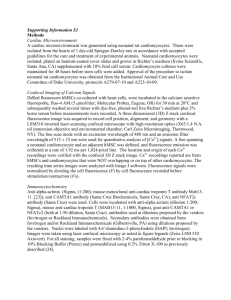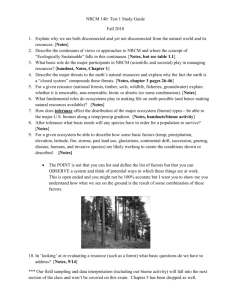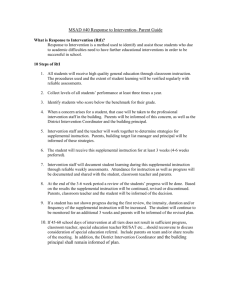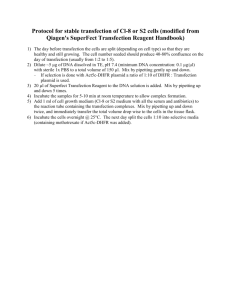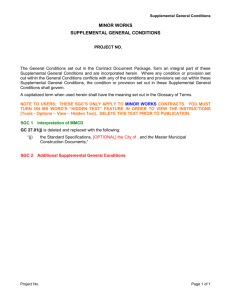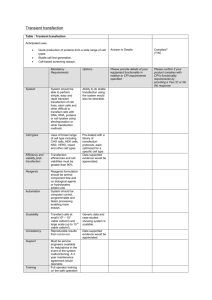SUPPLEMENTAL MATERIAL
advertisement
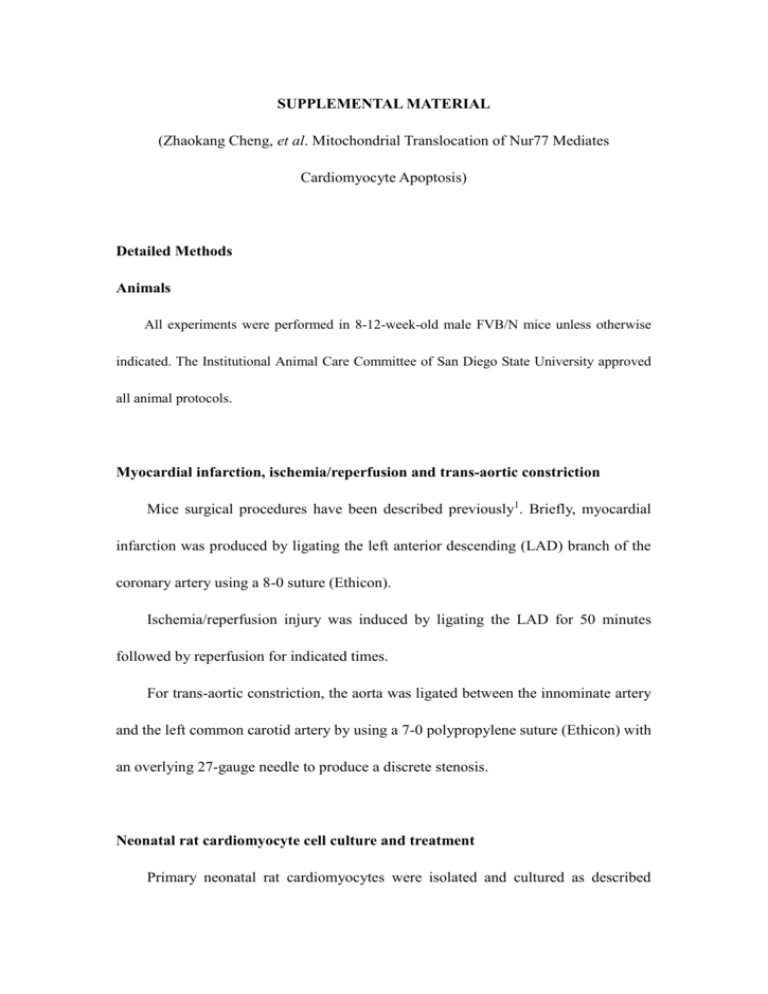
SUPPLEMENTAL MATERIAL (Zhaokang Cheng, et al. Mitochondrial Translocation of Nur77 Mediates Cardiomyocyte Apoptosis) Detailed Methods Animals All experiments were performed in 8-12-week-old male FVB/N mice unless otherwise indicated. The Institutional Animal Care Committee of San Diego State University approved all animal protocols. Myocardial infarction, ischemia/reperfusion and trans-aortic constriction Mice surgical procedures have been described previously1. Briefly, myocardial infarction was produced by ligating the left anterior descending (LAD) branch of the coronary artery using a 8-0 suture (Ethicon). Ischemia/reperfusion injury was induced by ligating the LAD for 50 minutes followed by reperfusion for indicated times. For trans-aortic constriction, the aorta was ligated between the innominate artery and the left common carotid artery by using a 7-0 polypropylene suture (Ethicon) with an overlying 27-gauge needle to produce a discrete stenosis. Neonatal rat cardiomyocyte cell culture and treatment Primary neonatal rat cardiomyocytes were isolated and cultured as described 2 previously1. Cells were serum-starved in 0.5% FBS for 48 hours before treatment with hydrogen peroxide (H2O2, 50μM or 10μM, Fisher BioReagents) for the indicated times. Plasmid construction Nur77 cDNA and a Nur77 mutant lacking the DNA binding domain (Nur77/ΔDBD-GFP) were kindly provided by Dr. Xiao-kun Zhang (Burnham Institute, San Diego, CA). Nur77 cDNA was subcloned into the pShuttle-CMV vector at the NotI site. Then GFP cDNA (HindIII/HpaI double digestion from pEGFP-N1) was subcloned at the HindIII/EcoRV site. Nur77-GFP fusion gene was generated through a T to G mutation of the Nur77 stop codon using the QuikChange XL site directed mutagenesis kit (Stratagene, La Jolla, CA). Schematic diagrams of plasmids used in this study were shown in Supplemental Figure I. Adenoviral infection, plasmid and siRNA transfection Nur77-GFP adenovirus was made by using the AdEasy XL Adenoviral Vector System (Stratagene, La Jolla, CA). NRCM were infected with adenovirus at multiplicity of infection (MOI) 50 for 2h, washed in PBS, and then refed with M199 with 0.5% FBS and antibiotics. Plasmid transfection of NRCM was performed by using the Effectene transfection reagent (Qiagen) following manufacturer's instructions. Briefly, 1μg DNA was diluted in the DNA-condensation buffer to a total volume of 100 μl. Ten 3 microliter of Enhancer and 20μl of Effectene transfection reagent were added to the DNA solution, respectively. The transfection complexes were finally added drop-wisely onto the cells cultured in chamber slides. NRCM were transfected with small interfering RNAs (siRNAs, 25nM) by using HiPerfect transfection reagent (Qiagen) as per the manufacturer’s recommendations. Briefly, 3μl siRNA and 12μl HiPerfect were diluted in 100μl serum-free M199 medium. After incubation for 5-10 minutes, transfection complexes were added to the cells for 48h. The following siRNA sequences were used: rat Nur77 siRNA, 5’-UGG CCC AGA GUU CCC UGA AGU UG UU-3’; The scrambled siRNA was obtained from Ambion. Real-time RT-PCR Total RNA was isolated from frozen heart or cultured cells by using Quick-RNA™ MiniPrep (Zymo Research) and reverse-transcribed into complementary DNA (cDNA) by using High Capacity cDNA Reverse Transcription Kit (Applied Biosystems). Real-time PCR was performed on all samples in triplicate using QuantiTect™ SYBR Green PCR Kit (Qiagen) according to the manufacturer’s instructions. All primer sequences are shown in Online Table I of the Online Data Supplement. Subcellular fractionation Heart tissues were snap-frozen in liquid nitrogen, pulverized, and homogenized 4 in isolation buffer (70mM sucrose, 190mM D-Mannitol, 20mM Hepes, 0.2mM EDTA) by a Teflon-glass dounce homogenizer. NRCM were collected by scraping in isolation buffer and immediately disrupted by homogenization in a Dounce apparatus with a tight fitting pestle. Nuclear fractions were separated by centrifugation at 600g for 10min followed by discontinuous sucrose density centrifugation. Mitochondrial fractions were separated by centrifugation at 5000g for 15min. Cytosolic fractions were separated by centrifugation at 100,000g for 60min. Samples were resuspended in SDS sample buffer (8 mol/L urea, 50 mmol/L DTT, 2% SDS, 150 mmol/L Tris-HCl pH 6.8, 15% sucrose 2 mmol/L EDTA, 0.01% bromophenol blue), sonicated, boiled for 5 minutes and stored at -80C until used for immunoblotting. Immunoblotting Immunoblotting was performed as described previously2. Briefly, protein lysates from ventricles or cultured cardiomyocytes were loaded onto a 4-12% NuPAGE Novex Bis-Tris Gel (Invitrogen) for electrophoresis. Separated proteins were then transferred onto a polyvinylidene fluoride (PVDF) membrane, blocked with 5% skim milk in Tris-Buffered Saline Tween-20 (TBST) for 1 h at room temperature, and exposed to rabbit anti-Nur77 (sc-5569, Santa Cruz Biotechnology, 1:200), mouse anti-β-actin (sc-47778, Santa Cruz Biotechnology, 1:1000) and mouse anti-GAPDH (MAB374, Chemicon, 1:2000) overnight at 4ºC. Alkaline phosphatase (AP), horseradish peroxidase (HRP) or Cy5-conjugated IgG (Jackson ImmunoResearch, West Grove, PA) were used as secondary antibodies. Fluorescence signal was detected 5 and quantified by using a Typhoon 9400 fluorescence scanner together with ImageQuant 5.0 software (Amersham Biosciences). Immunohistochemistry and confocal microscopy Immunolabeling was performed as described previously2. Briefly, cultured cardiomyocytes were permeabilized in PBS containing 0.1M Glycine and 0.1% Triton-X100 for 5min, blocked with 10% horse serum in PBS for 1h, and incubated with rabbit anti-Nur77 (LS-B114, Lifespan Biosciences, 1:50), goat anti-heat shock protein 60 (HSP60, sc-1052, Santa Cruz Biotechnology, 1:50), mouse anti-cytochrome c (556432, BD Pharmingen, 1:50), mouse anti-α-actinin (A7732, Sigma-Aldrich, 1:100) at 4°C overnight. The next day, slides were incubated 1.5 h at room temperature with FITC, Cy3, or Cy5-conjugated secondary antibodies (Jackson ImmunoResearch Laboratories, 1:100). Nuclei were stained with To-pro-3 iodide or Sytox Blue (Invitrogen). Formalin-fixed paraffin-embedded mouse heart sections were deparaffinized, rehydrated, and antigen-retrieved in 10 mmol/L citrate, pH 6.0. After blocking in TNB buffer, slides were incubated with rabbit anti-Nur77 (LS-B114, Lifespan Biosciences, 1:100), mouse anti-tropomyosin (T9283, Sigma-Aldrich, 1:100) at 4°C overnight followed by FITC-conjugated donkey anti-rabbit IgG and Cy3-conjugated donkey anti-mouse IgG (Jackson ImmunoResearch Laboratories, 1:100) at room temperature for 1.5h. Nuclei were stained with Topro-3 iodide (T3605, Invitrogen, 1:10000). Confocal images were acquired by using a Leica TCS-SP2 or a Molecular Dynamics 6 CLSM 2010 confocal laser-scanning microscope (Leica). TUNEL staining TUNEL staining was performed by using the In Situ Cell Death Detection Kit, TMR red (Roche Applied Science) according to the manufacturer’s directions. Briefly, NRCM were fixed in 4%PFA and permeabilized with fresh permeabilization solution (0.1%Triton X-100 and 0.1% sodium citrate in PBS). Cells were then incubated with TUNEL reagent for 1h at 37°C and covered for examination by confocal microscopy. Flow cytometry NRCM were stained with Annexin V (BD Biosciences) and Sytox blue (Invitrogen) according to the manufacturer’s instructions. Briefly, cell pellet was collected by trypsinization and centrifugation, then incubated with Annexin V (1:50) and Sytox blue (1:1000) for 15min. Annexin V has a high affinity for the membrane phospholipid phosphatidylserine which is exposed to the external environment during early apoptosis. Sytox Blue is a high-affinity nucleic acid stain that easily penetrates cells with compromised plasma membranes but will not cross intact membranes in viable cells. Early apoptotic cells are Sytox Blue-/Annexin V+; Late apoptotic cells are Sytox Blue+/Annexin V+; Necrotic cells are Sytox Blue+/Annexin V-; and viable cells are Sytox Blue-/Annexin V-. Flow cytometry was performed by using a BD FACSAria Flow Cytometer (BD Biosciences). 7 Statistical analysis Statistical analysis was performed with the Windows SPSS 13.0 software package. All data are expressed as mean ± SEM. Comparisons were performed by using unpaired Student t-test or one-way analysis of variance (ANOVA) with Tukey’s post-hoc test as appropriate. All tests were two-sided and a value of P<0.05 was considered statistically significant. Supplemental Table I. Primer sequences for real-time PCR Species Gene Forward Reverse rat Nur77 5’-TGTTGATGTTCCTGCCTTTGC-3’ 5’-TGCGGTTCTGCAGCTCCT-3’ β-actin 5’-GAAGATCAAGATCATTGCTCCTCCT-3’ 5’-GAAGGTGGACAGTGAGGCCA-3’ GAPDH 5’- GACATGCCGCCTGGAGAAAC-3’ 5’-AGCCCAGGATGCCCTTTAGT-3’ Nur77 5’-GTCCGCTCTGGTCCTCATCA-3’ 5’-CCATGTGCTCCTTCAGACAGC-3’ ANP 5’-TCTGATGGATTTCAAGAACCTGC-3’ 5’-CTGCTTCCTCAGTCTGCTCACTC-3’ BNP 5’-GCAATTCAAGATGCAGAAGCTG-3’ 5’-CTGCCTTGAGACCGAAGGACT-3’ β-MHC 5’-GAGCCTTGGATTCTCAAACG-3’ 5’- GTGGCTCCGAGAAAGGAAG-3’ β-actin 5’-CATGAAGATCAAGATCATTGCTCCT-3’ 5’-GCTGATCCACATCTGCTGGAA-3’ GAPDH 5’- CATGGCCTTCCGTGTTCCTA-3’ 5’- CCTGCTTCACCACCTTCTTGAT-3’ mice 8 Supplemental Figures and Figure Legends Supplemental Figure I. Construction and confirmation of Nur77 mutants. (A) Schematic diagrams of Nur77-GFP and Nur77/ΔDBD-GFP. (B-C) Confirmation of protein expression. GFP-, Nur77-GFP-, or Nur77/ΔDBD-GFP-transfected cells were immunolabeled for Nur77 (B) or GFP (C), respectively, with non-transfected cells as a negative control. Both Nur77 and GFP bands appeared at the same size, confirming expression of the fusion protein. β-actin served as a loading control. 9 Supplemental Figure II. Myocardial Nur77 mRNA declines during postnatal development. qRT-PCR results of Nur77 mRNA levels in ventricular tissues of 2-day and 2-month-old mice, with 18S rRNA as an internal control (n=3). Values are mean ± SEM. ***P<0.001. 10 Supplemental Figure III. Nur77 expression is induced by myocardial infarction and pressure overload-induced hypertrophy. (A) Confocal images of myocardial sections at 3 days after infarction, with sham-operated animal as a control. Nur77 (green) localized in the nuclei (Topro-3, blue) of cardiomyocytes (tropomyosin, red) within the border zone adjacent to the infarct. Boxed regions in left are shown at higher magnification at right. Scale bar = 40μm (left) and 10μm (right); (B) Immunoblot shows cardiac Nur77 peaks at 3 days after infarction (n=3). * P<0.05 vs sham; (C) Confocal images of myocardial sections at 4 days after trans-aortic constriction, with sham-operated animal as a control. Nur77 (green) localized in the nuclei (Topro-3, blue) of cardiomyocytes (tropomyosin, red). Boxed regions in left are shown at higher magnification at right. Scale bar = 40μm (left) and 10μm (right); (D) Immunoblot shows myocardial Nur77 increased at 4 days after trans-aortic constriction (n=3). * P<0.05 vs sham; (E) Real-time RT-PCR showing Nur77 mRNA is increased by TAC together with the hypertrophy markers ANP, BNP and β-MHC (n=4). * P<0.05 vs sham; *** P<0.001 vs sham. 11 Supplemental Figure IV. Subcellular localization of Nur77 was not affected by ischemia. Mice were subjected to ischemia for 65 min or 170min. (A) Confocal images of sham and ischemic heart sections stained for Nur77 (green), HSP60 (red) and nuclei (blue). Nur77 localized to nuclei of cardiomyocyte in both sham and ischemic heart sections (arrows). Colocalization of Nur77 with HSP60 was not significant. Scale bar = 20μm; (B-E) Subcellular fractionation performed in sham-operated and ischemic hearts (n=3). Whole cell (B), nuclear (C), cytosolic (D) 12 and mitochondrial (E) lysates were probed for Nur77 and normalized to β-actin, H3 (nuclear marker), GAPDH (cytosolic marker) and VDAC (mitochondrial marker). *P<0.05, **P<0.01. Supplemental Figure IV. Ischemia Reperfusion cause oxidative DNA damage. Mice were subjected to ischemia for 50min and then reperfusion for 15min. Confocal images of sham and I/R treated hearts stained for 8-Hydroxy-2'-deoxyguanosine (red) and desmin (blue). 8OH-dG localized to the nuclei of cardiomyocytes in IR heart sections. Inlets are shown on the right. Bar 40M. 13 REFERENCES 1. Muraski JA, Rota M, Misao Y, Fransioli J, Cottage C, Gude N, Esposito G, Delucchi F, Arcarese M, Alvarez R, Siddiqi S, Emmanuel GN, Wu W, Fischer K, Martindale JJ, Glembotski CC, Leri A, Kajstura J, Magnuson N, Berns A, Beretta RM, Houser SR, Schaefer EM, Anversa P, Sussman MA. Pim-1 regulates cardiomyocyte survival downstream of Akt. Nat Med. 2007;13:1467-1475. 2. Tsujita Y, Muraski J, Shiraishi I, Kato T, Kajstura J, Anversa P, Sussman MA. Nuclear targeting of Akt antagonizes aspects of cardiomyocyte hypertrophy. Proc Natl Acad Sci U S A. 2006;103:11946-11951.
